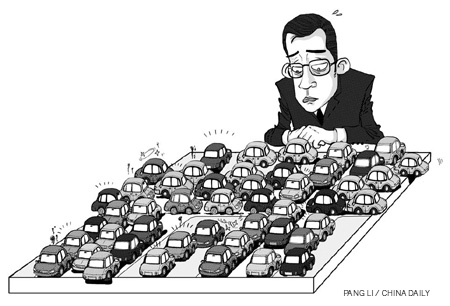-
News >Bizchina
Time to fix traffic in Beijing
2010-12-21 14:48
Today we get caught in hyper congestion, but not in a bit of surprise, for we knew it was coming long ago.
Back in 1995, right after the Chinese government announced a new policy to develop the auto industry as one of the national pillar industries and to promote domestic market for household cars, the World Bank anticipated that traffic congestion would soon become a mega-city woe.
With increasing household incomes and declining purchase prices of private cars, more and more households could afford to buy one. Private cars also become more attractive when cities grow bigger and average commuting distance longer. But urban land is limited, so is the space devoted for roads.
Based on international experience, the World Bank recommended a wide range of prescriptions for Chinese cities to avoid traffic congestion getting out of control.
Some are supply-side measures to better manage road space for buses and bicycles and to build necessary high-capacity roads. Others are demand-side measures including non-pricing controls on vehicle ownership and use (such as restriction on the days of use), and pricing controls such as fuel taxes and congestion pricing. All these measures have successfully been adopted in other more advanced countries and cities, and are now the main topics of daily debate in Beijing.
The World Bank warned the Chinese mega-cities that no major cities around the world had built out of congestion, and further suggested cities introduce demand-side measures early, before the urban car-owning group locked in a lifestyle of free mobility.
But a city heading toward hyper congestion is often like a patient not wanting to take the tough dose of medicine until the illness becomes too serious. It is politically difficult to do the right things before the problem is felt.
After all, cities always have a number of priorities to meet; so why bother to control traffic when it is still moving? This is exactly the same mistake many developing cities have made.
In response to the growing level of traffic, many mega-cities and large cities in China opted to widen existing streets and build more roads for cars, sometimes by demolishing roadside trees and bicycle lanes and squeezing pedestrian space. They all tried to avoid upsetting the car-owning group by not using non-pricing or pricing controls on vehicle ownership and use, unless there was no alternative.
As a result, car users get the hidden subsidies because much of the urban transport investment and available capacity benefits them. They don't know it, though. Now they have become a much bigger group and are badly spoiled. Hyper congestion seems to be the natural revenge.
Seoul, the capital of the Republic of Korea (ROK), has gone through a similar problem. The city reached hyper-congestion level in the mid-1990s, just a few years after the ROK exported its cars to the West. This happened despite the presence of city's wide boulevards.
To alleviate traffic congestion, Seoul first opted to subway development and tried to avoid any direct action to reduce road congestion and car use. Very soon, the Seoul government faced increasing subsidies for the subways and deteriorating quality of bus services. The newly added road infrastructure was quickly filled with new users.Then the government was forced by the situation to introduce a network of dedicated bus lanes and the peak-hour congestion pricing to the two key tunnels through the central area of Seoul. In 1997 the government went on to increase gasoline taxes and road user charges. It also raised parking fees at public parking facilities almost every year, and reduced the required number of parking spaces in the new commercial and office buildings in the city center.
With these came the most dramatic action in 2003 when the current ROK President Lee Myung-bak was the mayor of Seoul. The city demolished a 6-kilometer elevated highway built above the Cheonggyecheon River, restored the previously covered river, and built a Bus Rapid Transit line along the corridor. The only comparable action in China is probably Shanghai's turning the Nanjing Road into a pedestrian shopping street.
Today, Seoul's traffic congestion problem is not yet over. But the situation is well under control, thanks to its world class public transport system and numerous on-going measures to control car use and promote safe walking and bicycling.
I recall a quotation from the transport profession in the West: No one would sit in congestion forever.
Travelers who get caught in congestion would try to find a way to escape if there are other options. Those who sit in traffic and complain aloud are right if they don't have an alternative. The job of the city government is to provide the alternative - better buses, safer bicycling, easier access to subways.
The non-pricing and pricing controls of vehicle ownership and use in congested cities are just the means to correct the long-standing policy distortions, and create the right incentive for car users to shift to other modes of transport. It is time for Beijing's car-owning group to understand this. It is time for Beijing to adopt demand-side controls.
The author is lead infrastructure specialist of the World Bank Office, Beijing
